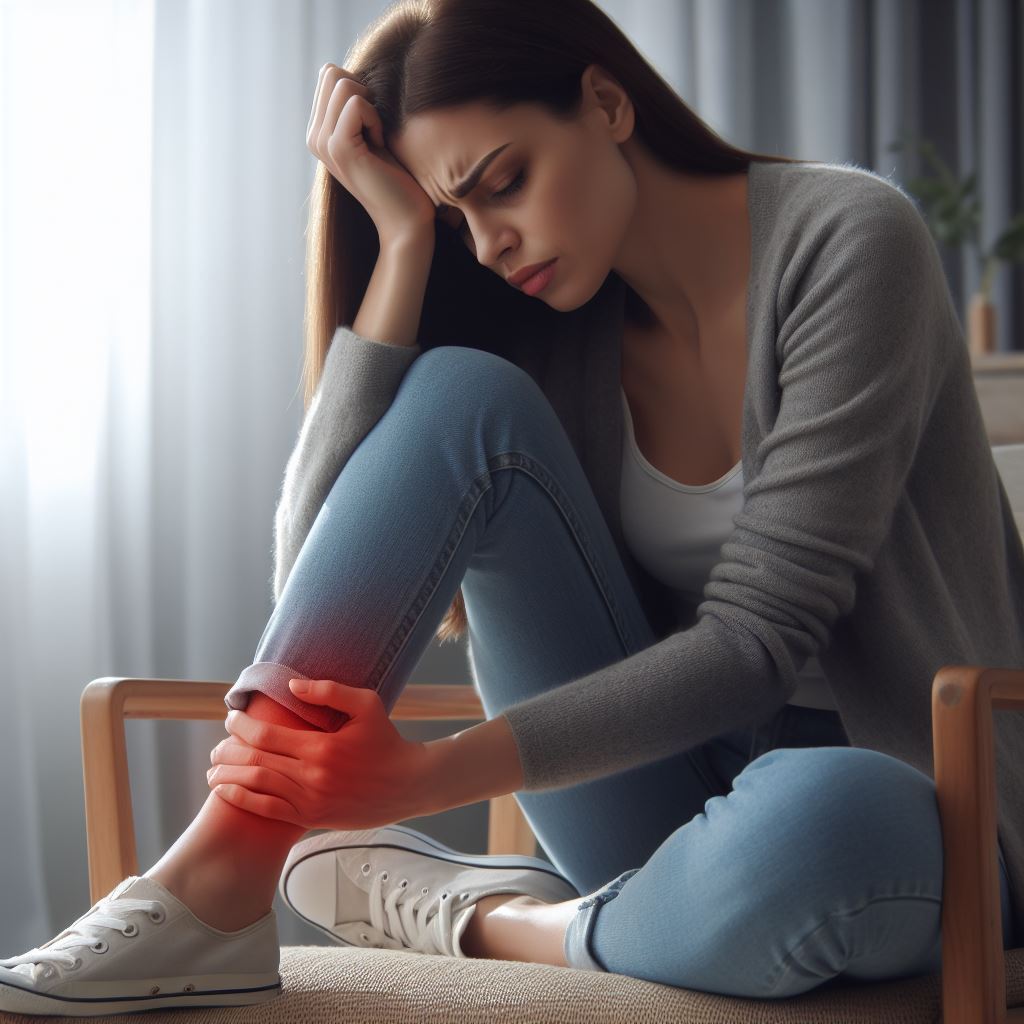While there are various causes of leg pain ranging from strenuous exercise to underlying medical conditions, many people seek leg pain natural remedies to alleviate their discomfort.
Leg pain can be a frustrating and debilitating condition, impacting your ability to move and carry out daily activities comfortably.
Using natural solutions as part of your self-care practice can help you feel better and may work well with traditional medical treatments.

There are many home treatments that can help, but some of the most common ones are getting enough rest, using ice packs, and applying gentle pressure.
Another way to help reduce pain and stiffness is to elevate the leg that is hurt.
Long-term management includes making changes to your food, doing regular physical activities that are right for you, and thinking about alternative therapies.
These techniques are meant to lower inflammation, build muscle, and boost blood flow. All of these things can help a lot with leg pain.
To keep yourself healthy and safe, you need to pay attention to how your body reacts and know when to get professional medical help.
Key Takeaways
- Natural remedies can reduce leg pain and should be used alongside proper rest and recovery.
- Dietary choices and physical activities contribute to long-term leg pain management.
- Know when to consult a healthcare provider to address persistent or severe leg pain.
- Stretching exercises can help to reduce tension in the leg muscles and promote relaxation.
- Leg pain and muscle cramps are commonly caused by dehydration.
Understanding Leg Pain
When you experience discomfort in your legs, it’s often a result of issues with muscles, joints, or even your blood vessels. Knowing the causes and recognizing the symptoms can help you cope better and decide when to seek help.
Common Causes of Leg Pain
Leg pain can stem from a variety of causes, and understanding these is crucial for finding relief.
Muscle strain is a frequent culprit, often due to overuse or injury.
Conditions such as arthritis—which includes osteoarthritis and rheumatoid arthritis—contribute significantly to joint pain and inflammation in the legs.
Swelling and pain in the leg can also arise from vascular disease, a condition affecting the blood vessels, which can lead to varicose veins and in severe cases, life-threatening complications.
Diabetes can lead to a specific type of pain known as diabetic neuropathy, where the nerves in the legs and feet are damaged.
Injuries to bones, ligaments, or tendons, such as sprains, strains, and fractures, are also common sources of leg pain.
Additionally, nerve conditions like sciatica—which is the irritation of the nerve that runs from the lower back down to the legs—can cause intense leg pain.
Symptoms Associated With Leg Pain
Your leg pain could be accompanied by a range of symptoms, depending on the underlying cause.
For muscle-related pain, you might experience cramps, spasms, or a sharp, localized pain which suggests a muscle strain.
Injuries might exhibit visible swelling, bleeding, or you may notice that you can’t put weight on the affected leg.
Joint issues from arthritis typically come with stiffness, inflammation, and reduced mobility.
If you have a vascular issue, you could see varicose veins, feel a throbbing sensation in your legs, or notice them being unusually warm or cool to touch.
Joint and muscle pain in the legs may be caused by insufficient blood circulation.
Source: chiro-med.ca
It’s important to be aware that leg pain can connect to broader health issues. For example, musculoskeletal pain can be related to overarching back pain, or infections in your body may manifest with related pain in the legs, sometimes accompanied by a fever or a headache.
Always pay attention to additional symptoms as they can offer clues about the source of your leg pain.
Dietary Adjustments for Leg Pain Relief
When it comes to reducing leg pain, what you put on your plate matters just as much as topical treatments or activities. Focusing on anti-inflammatory foods and proper hydration can play a significant role in managing discomfort.
Anti-Inflammatory Foods
Incorporating anti-inflammatory foods into your meals can help address the inflammation that often accompanies leg pain.
Start by adding a dash of turmeric to your dishes, which contains a compound called curcumin known for its anti-inflammatory properties. Pair turmeric with black pepper to enhance absorption.
You can also up your ginger intake, another powerful root with similar benefits.
Don’t forget your greens and other vegetables, which are packed with nutrients that support muscle health.
Foods high in magnesium, such as spinach and pumpkin seeds, may also help alleviate leg pain.
- Examples of Anti-Inflammatory Foods:
- Turmeric (enhanced with pepper for absorption)
- Ginger
- Vegetables (spinach, kale, broccoli)
- Fruits packed with antioxidants (berries, oranges)
- Foods rich in magnesium (pumpkin seeds, almonds)
Integrating these ingredients into your diet can be as simple as blending them into smoothies or including them in main courses and salads.
Hydration and Leg Pain
Staying hydrated is key to maintaining good health and can specifically aid in leg pain relief.
Hydration helps in muscle function and reducing cramps, which can be a source of leg pain.
Ensure you’re drinking enough water throughout the day, and consider introducing apple cider vinegar into your routine for its potential pain-relieving properties.
- Hydration Tips:
- Aim for at least 8 glasses of water daily
- Incorporate foods with high water content (cucumbers, watermelon)
- Add a tablespoon of apple cider vinegar to a glass of water as a morning tonic
Natural Remedies and Home Treatments
When you’re dealing with leg pain, there are effective natural remedies and home treatments you can try. From herbal solutions to soothing topical applications, these methods can help alleviate your discomfort without the need for pharmaceuticals.
Herbal Remedies for Leg Pain
You don’t have to look far for natural pain relievers; your kitchen may already hold a treasure trove of herbs that can help.
Drinking ginger tea is known to reduce inflammation and can ease your leg pain.
Alternatively, adding a spoonful of turmeric to your meals or milk can also provide relief due to its anti-inflammatory properties.
If you’re interested in an in-depth list of natural ingredients, look into these home remedies for leg pain.
Topical Applications
Applying natural substances directly to the affected area can help reduce pain significantly.
For instance, capsaicin, which is derived from chili peppers, is great for temporary pain relief when used as a cream.
Eucalyptus oil and oil made from cloves can be gently massaged onto the leg to provide a warming sensation that distracts from pain.
Another option is to soak in a warm bath with Epsom salt which can help with muscle relaxation and pain relief.
Heat and Cold Therapy
Alternating between heat packs and cold compress is a tried-and-true method to fight leg pain.
Heat helps by relaxing your muscles and improving circulation, while cold helps reduce inflammation and numbs deep pain.
It’s easy – apply a heat pack for about 20 minutes, then a cold compress for another 20 minutes.
Remember, always wrap the heat or cold source in a cloth to protect your skin. Get a deeper comprehension of these treatments using these natural remedies for tendinitis inflammation and pain.
Physical Activities and Exercises
When you’re dealing with leg pain, incorporating appropriate physical activities and exercise can help strengthen your muscles, improve mobility, and alleviate discomfort.
It’s about finding the right balance that does not overexert your legs but keeps them actively engaged.
Exercise Routines for Leg Strength
Regular exercise can boost the strength of your legs, thereby lessening the burden on your joints and muscles.
Start with low-impact activities such as walking or stationary biking, which put less pressure on your feet and joints.
Aim for at least 30 minutes a day, ensuring you stay hydrated to prevent dehydration and related leg cramps.
- Walking: Begin with short distances and gradually increase your pace and distance.
- Leg Presses: Use a light weight to avoid overload.
Stretching and Flexibility
Enhancing your flexibility can alleviate pressure and improve mobility in your legs.
Focus on stretching exercises that lengthen and relax your muscles, such as calf stretches and hamstring stretches, which you can do before and after your workouts.
This habit will help you prevent leg cramps and maintain muscle health.
- Calf Stretch: Place your hands on a wall for balance and extend one leg behind you, keeping the heel down.
- Hamstring Stretch: Sit on the ground and reach forward to touch your toes.
Yoga and Relaxation Techniques
Yoga combines physical postures, stretching, and relaxation techniques, which may help improve flexibility, reduce tension, and promote circulation in your legs.
Poses like Downward Dog and Warrior can be particularly beneficial for those looking to ease leg pain.
- Yoga Poses: Try Tree Pose for balance and Downward Dog for a full-leg stretch.
- Relaxation: End each session with a few minutes of Shavasana to let your muscles relax and recover.
Alternative Therapies

When you’re dealing with leg pain, sometimes traditional medicine doesn’t give you the relief you’re seeking. That’s when looking into alternative therapies might just be the ticket to improve your quality of life.
Let’s explore a couple of options that could offer you some relief.
Acupuncture and Pressure Points
Acupuncture, a staple in traditional Chinese medicine, involves inserting very thin needles into specific points on your body. It’s thought to stimulate nerves, muscles, and connective tissue, which can boost your body’s natural painkillers and increase blood flow.
If you’ve got conditions like tendonitis, you might find acupuncture particularly beneficial.
Pressure points, on the other hand, can be stimulated through less invasive techniques like acupressure or Shiatsu massage to promote relaxation and pain relief.
Chiropractic and Manual Therapy
Chiropractic care isn’t just for your back—it can also be applied to other parts of your body, including your legs. This form of manual therapy focusses on the musculoskeletal structure, ensuring your body’s bones are aligned and balanced, which can help ease pain and improve function.
Treatments might involve hands-on adjustments or other joint and soft tissue work. It’s especially useful if you’re looking for a therapy that incorporates movement and relaxation techniques.
Lifestyle Changes

Adopting certain lifestyle changes can significantly impact your comfort and mobility if you’re experiencing leg pain. These adjustments aim to reduce the strain on your legs and improve blood flow, potentially easing that nagging soreness or stiffness.
Weight Management
Managing your weight can take a considerable load off your legs. If you’re overweight, every step you take puts extra pressure on your joints, which can worsen leg pain.
By maintaining a healthy weight, you may notice improved mobility and a decrease in discomfort.
Improving Circulation
Improving your circulation can lead to better blood flow, which is crucial for tissue health and pain reduction. Simple practices like elevating your legs or staying active can boost circulation.
Regular exercise, especially low-impact activities like swimming or cycling, can help prevent and reduce stiffness as well as improving circulation.
When to Seek Medical Attention
If you’re dealing with leg pain, it can sometimes be tricky to know when it’s time to shrug it off or when to book an appointment with your doc. However, when the discomfort starts messing with your usual vibe, it’s a nudge to get checked out, just to be on the safe side.
Recognizing Serious Conditions
Chronic diseases: Y’know, stuff like diabetes or peripheral artery disease can invite leg pain to the party. If the pain in your legs is persistent, particularly if you’ve got a chronic condition humming in the background, your body could be waving a red flag for help.
Illness or Infection: Got signs like redness, warmth, or swelling in your leg? It could be your immune system putting up a fight against an infection. If your leg starts looking funky or feeling excessively tender to the touch, don’t just let it slide—get some medical attention.
Severe Symptoms: Let’s get real, if your leg pain is severe, like can’t-walk severe, or it’s coming with a side of scary symptoms—think chest pain, difficulty breathing, or a sudden, intense headache—don’t second guess it. That’s serious conditions territory, and you should make moves to the ER, stat.
Safety and Precautions
When it comes to natural remedies for leg pain, it’s super important to think about safety and how different treatments might interact with your body. Even though they’re “natural,” that doesn’t automatically make them risk-free, especially if you’re already taking some medications or have specific health conditions.
Understanding Side Effects
Just ’cause something is natural doesn’t mean it can’t have side effects. For example, some herbs can cause reactions if you’re allergic or if they mix poorly with prescription meds you might already be on.
Always check with your healthcare provider before starting any new treatment, especially if you’re treating leg pain in children – they’re more sensitive to stuff, and what’s safe for an adult might not be safe for them.
Natural Does Not Always Mean Safe
Let’s clear something up: natural pain relief options, like the ones found at emedihealth or Medical News Today, come with their own set of risks.
It’s a bit like cooking – just because you’re using all-natural ingredients doesn’t mean you can’t burn dinner. Take the time to research any remedy you’re considering, and if in doubt, talk to a pro who knows their stuff.
Frequently Asked Questions
If you’ve been on your feet all day or you’re feeling the effects of a workout, you might be looking for natural ways to relieve that leg pain. Let’s tackle some of the most common questions you might have.
What’s a good way to soothe my aching legs naturally?
A simple yet effective method to alleviate leg pain is through rest and elevation. Elevating your legs can help reduce swelling and pain. You might also try gentle stretches or yoga to improve circulation and relax the muscles.
Got any tips for quick relief from leg pain without popping pills?
For immediate pain relief, applying an ice pack to the affected area can numb the pain and reduce inflammation. Remember not to apply ice directly on the skin; wrap it in a cloth first.
Can you suggest any home remedies for leg cramps during the night?
To prevent or relieve night-time leg cramps, ensure you’re staying hydrated throughout the day. Magnesium-rich foods may also help as magnesium can improve muscle function and potentially reduce cramps.
Are there any effective Ayurvedic treatments for leg discomfort?
Ayurvedic practices often include the use of herbs such as turmeric for their anti-inflammatory properties. Regular massages with herbal oils may also improve circulation and provide relief.
What can I massage onto my legs to ease the soreness?
Massage therapy can be quite beneficial. For a DIY approach, gently massage your legs with warm oil; some individuals find essential oils like peppermint or eucalyptus mixed with a carrier oil can provide a soothing effect.
How can I deal with leg pain that flares up after a long day?
After an extensive day, low-impact activities such as swimming or a leisurely walk can help ease muscle tension.
Heat therapy like a warm bath or heat compresses can also soothe sore muscles and improve joint mobility before bedtime.

